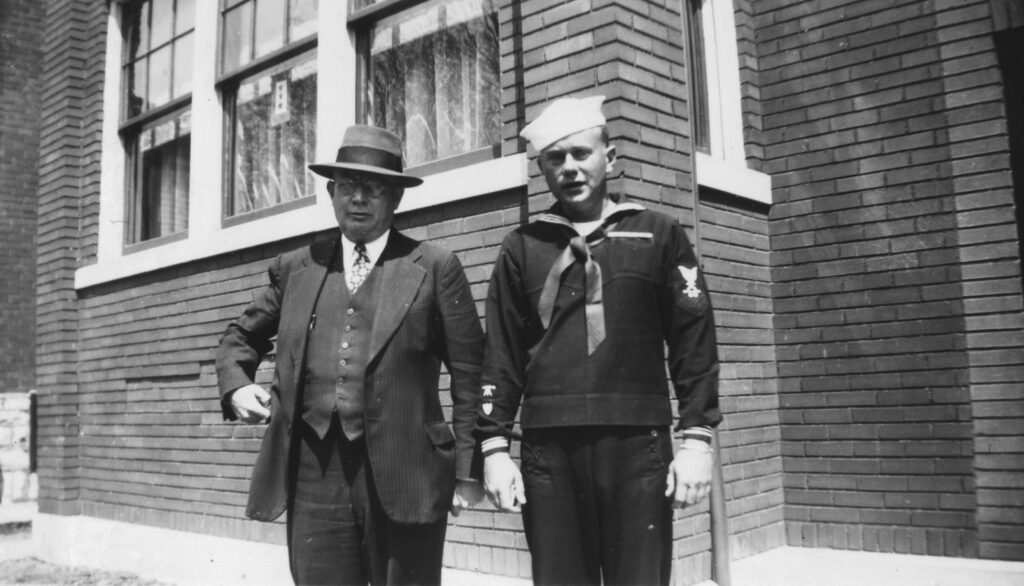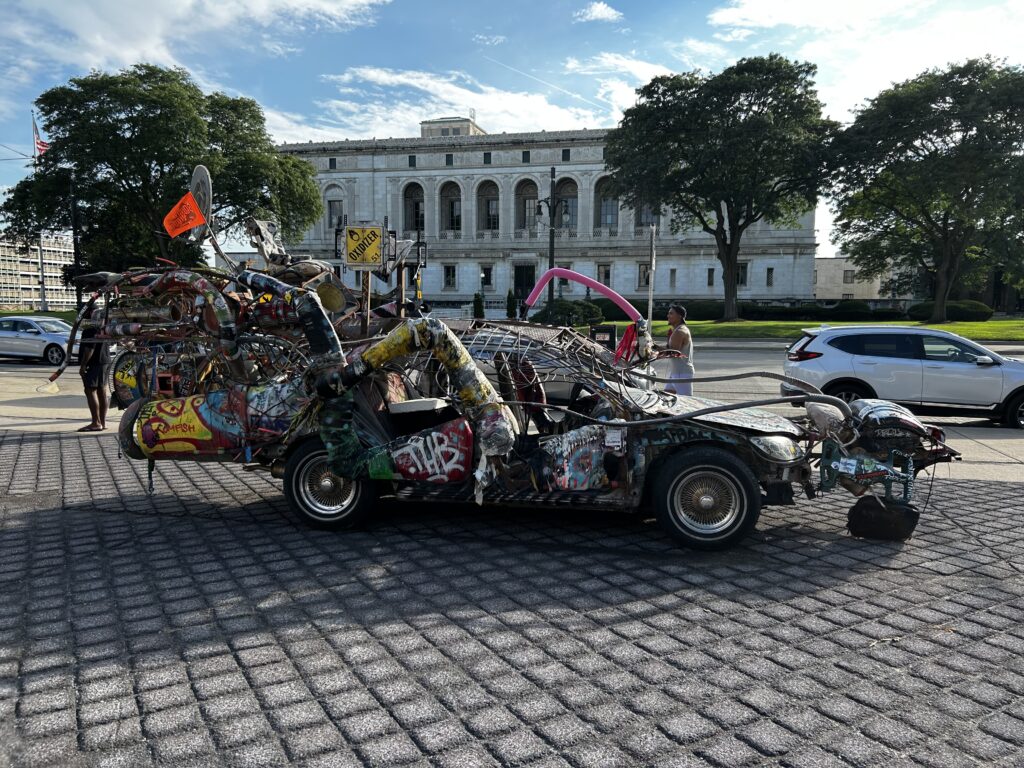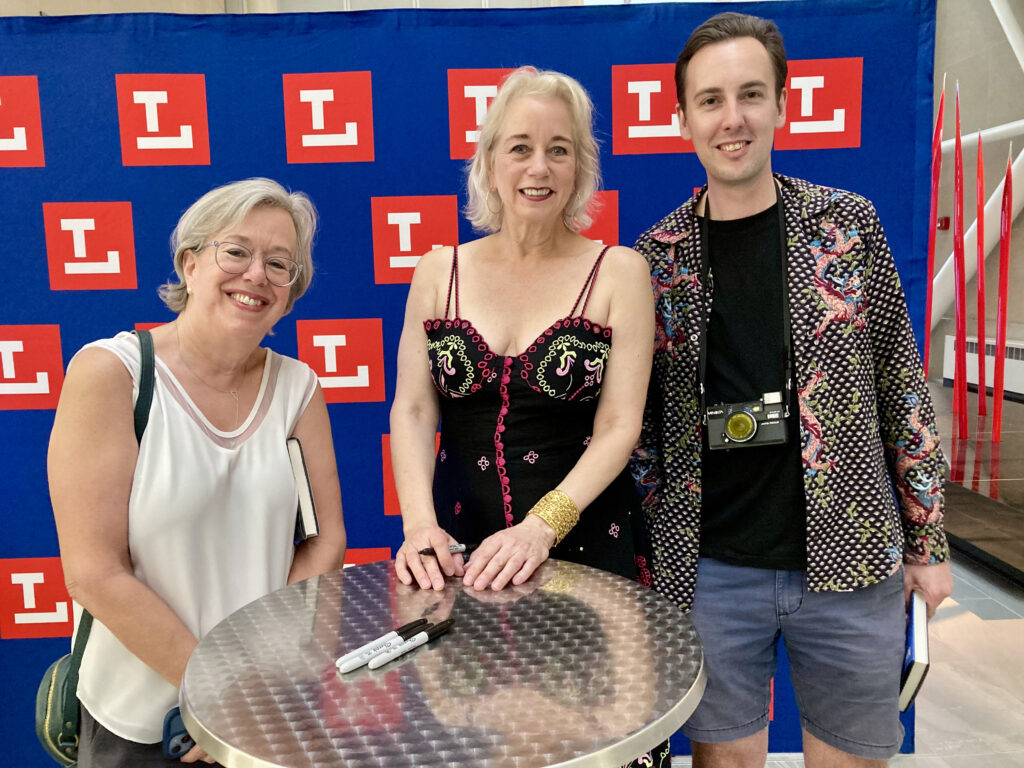It doesn’t qualify as a profound insight to notice that every child — hell, every person — alive today will have their photo taken a million times before they check out. Maybe more than that, if you throw in security cameras, which I’m not. I’m talking about how, as cameras have become omnipresent, we’re all more comfortable with having our picture taken.
If you grew up in the era where your parents might expose a single roll of film in six months, it’s a little unnerving. Yes, it’s great to have a bunch of pictures of your family. Yes, it’s also weird to point a camera at a child, and have them immediately step into a pose and flash a big insincere smile, the way mom and dad taught them. Where are the sullen teens of yore? Whatever.
Anyway, that’s all leading up to this: One of the things I did this weekend was go through some family pictures and artifacts my sister’s been keeping. I brought home my birth certificate, my high-school diploma, and a few snapshots.
My dad and his dad, whom I never met, c. 1943. My dad was meticulous in his appearance, and had his uniform tailored to his specifications. Looking at my grandfather, I can see it ran in the family.

I don’t know when that was taken, but St. Louis was a hot city. Imagine wearing a three-piece suit in that humidity.
Me and my brother, and me and my sister. This would be our house in Kansas City, most likely:


I had a bad problem with blinking when flashbulbs went off.
My very earliest memories were in that house; I think I must have been about…4? Maybe? After K.C., it was on to Columbus, where we settled and stayed.
Now these photos have been scanned and digitized, but I’ll keep the originals, where they’ll live in my family until Kate takes them, or throws them away, or they burn up in a fire.
I should toss my high-school diploma, though. Finishing high school is so bare-minimum, I wonder why anyone hangs on to theirs. But it seems wrong, somehow. Mine still has the sheet of onionskin paper that covers the precious diploma itself. It’s a thing of value! It cost the state of Ohio something to educate me. Better find a box to stash it in.
Also, this: I applied for a job a few years ago, not really wanting it, but curious what it might involve, and I was rejected for, get this, failing to attach a college transcript to my application, which was submitted online, of course. I think my college transcript must be in a moldy box in the basement of the registrar’s office, but never mind that, because it makes a pretty good segue to the bloggage, which today is a little dated. I’ve been throwing links into a blank doc for a few days now, so let’s lead with the evisceration of Indiana University, victim of a MAGA governor seeking to polish his national profile by gutting a fine institution. All in the name of “efficiency” and the needs of the job market, of course, which tracks with the right-wing insistence that college need be nothing more than a trade school for middle managers. (At least for your kids. The elite layer of the GOP will continue to send their offspring to the Ivies.) This Chicago Tribune editorial strikes the right note of are-you-kidding-me indignation, more so than any Indiana newspaper I’ve seen. But then, lots of IU journalism grads find jobs in Chicago, so no surprise there.
Here’s an amusing obit for a 105-year-old woman, a real GP OG, as I like to think of these dowagers:
Louise Booth, 105, passed away peacefully Thursday, July 3, 2025, at her home facing Lakeshore between Beacon Hill and Kerby in Grosse Pointe Farms. She was still of sound mind.
That’s a Booth of Booth Newspapers, back when owning newspapers was like owning a gold mine. They sold to Newhouse years and years ago, but they must have invested the pile wisely. Later paragraphs give the exact address of the house, in case any funeral burglars were confused. And while the obit isn’t amusing in the fashionable current trend of basically calling someone a lovable jerk — she seemed like a nice lady — I find any obit for someone who lasts that long into the postseason uplifting to read. Especially as she was still of sound mind.
The Sean Combs verdict happened so long ago it already feels like ancient history, but Monica Hesse at the WP has done a couple of good columns about it, which you can look up. This one, about so-called Alligator Alcatraz, is very good, too:
The point is that serious matters — the most serious matters, the matters of constitutionality, due process, citizenship and who gets to be an American — are, in this administration, being increasingly presented as cheap entertainment. You see it in the U.S. Border Patrol playing the power ballad “Closing Time” over footage of a scared looking young man being placed in handcuffs and shepherded onto a plane. You see it in the White House posting a video of detained migrants being processed for deportation, set to a hit from Bananarama.
Is it funny? Is it awful? Is it trolling or real life? The point is that we are not supposed to know. Alligator Alcatraz is a dehumanizing place, but when it is treated as spectacle, it’s not just the prisoners there who lose their humanity. We all do. The effect is to tell Americans not to take any of this too seriously. Families are being ripped apart, but it’s all for the lulz. We are dancing on the edges of constitutionality, but it’s making great television. We have become tonally incoherent, incapable of even determining tone. If Guantánamo Bay opened today, there would be a themed restaurant out back with happy hour specials taglined “Git mo’ at Gitmo.”
…I used to wonder about Roman gladiator battles. What kind of society would pack up a picnic lunch and go watch other humans, the enslaved or prisoners of war, forced to battle each other to the death? Another part of the gladiator legend is that these men were forced to fight large beasts, large carnivorous predators. But there was no physical evidence for that until just a few months ago in April, when archaeologists analyzed giant bite marks on the unearthed skeleton of a 1,800-year-old gladiator. Then it was confirmed: lions. In what society would this be a pleasant way to spend an afternoon?
Finally, a really interesting Atlantic story (gift link, as is the WP link above) about so-called customer-service sludge. Having recently spent 90 minutes on hold with the IRS without getting anyone on the line, I can identify. It’s maddening.










